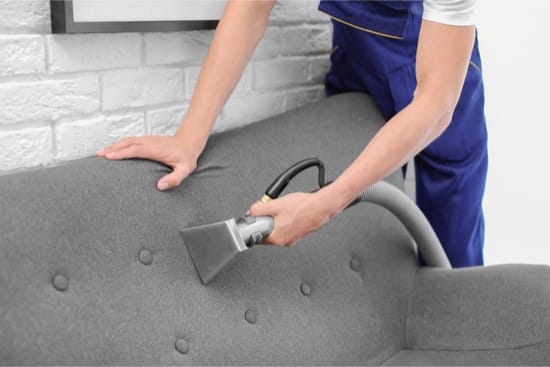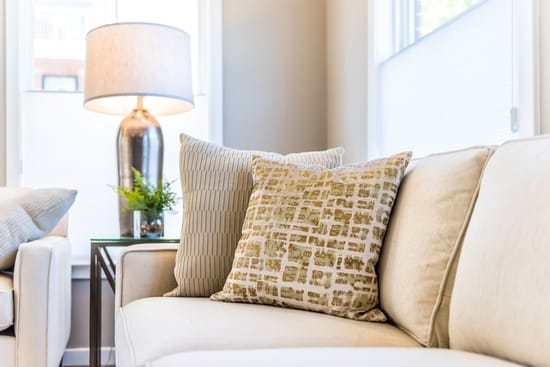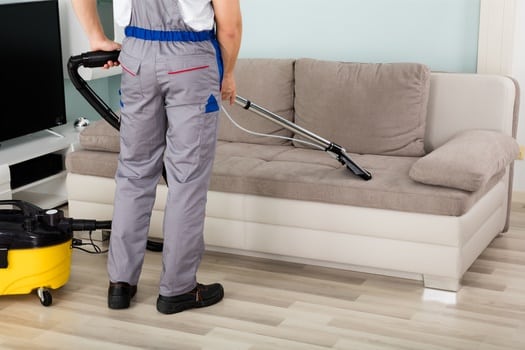Bed bugs will hide in the couch to avoid light and easy detection. They can make use of folds, cushions, and the frame. This can make bed bugs and their eggs really difficult to find.
Seal off the room so that the bed bugs can’t escape. Check the cushions, the area underneath, and the frame for bed bugs. Other signs include dead bed bugs in the couch, old shells, and feces. You can also use traps to find bed bugs in your couch.
If you don’t check for bed bugs in your couch, and take active steps to kill them, the infestation will spread further. So, read on to learn more about each of the signs, and take action right away.
Do Bed Bugs Infest Couches?
Bed bugs infest furniture and bedding. In small infestations, it’s likely that they will only live in your mattress. This is as close as they can get to you while you’re asleep. It means they don’t have to travel far to feed.
In larger infestations, bed bugs will set up infestations further from their original harborage. When a female is ready to lay eggs, she moves away from her current home. They spread to other parts of the mattress and other furniture. Here’s some info on where bed bugs lay their eggs.
It’s at this point that they might infest your couch. But they will infest it even quicker if you sleep on the couch occasionally. They will follow you to the couch and stay there if you sleep there.
Bed Bugs in Couch Only?
It is unlikely that you have bed bugs in your couch but not in your mattress. Bed bugs gravitate towards your sleeping area. It’s from these areas that they then spread around the house.
This is likely if you sleep on your couch. If you sleep on your couch permanently, then they will infest it first. But if you sleep in your bed, and only occasionally on your couch, it’s more likely for them to infest your mattress.
Bugs in Couch (Not Bed Bugs)
Bed bugs aren’t the only insects that hide in couches. Other bugs that might make their residence in your living room couch include:
- Fleas
- Carpet beetles
- Dust mites
- Cockroaches
Carpet beetles feed on fabric, of which there is plenty in your couch and cushions. Dust mites feed on dust/dead skin, which again there will be lots of. Fleas feed on blood like bed bugs, so will feed on anybody sat there. Cockroaches feed on old food.
The bugs are also attracted to the couch because it’s an excellent place to hide. If they live in the frame, they will seldom be disturbed.
Can You Get a Bed Bug Proof Sofa?
Making your sofa bed bug proof could involve putting an encasement on it. But you could also buy a couch that would be difficult to infest. Any couch with a wooden frame would make a good home for a bed bug. So, consider buying one with a metal frame.
The longer the legs on the couch, the less easily it’s infested, too. Bed bugs struggle to climb up some smooth surfaces. And the less material there is in the frame, the better, as there will be fewer places to hide.
A couch without couch cushions would also be awkward for bed bugs to hide in. So, you do have options. If your couch meets these descriptions already, then you might not find any bed bugs when you check for them.

Signs of Bed Bugs in Couch
If you want to search for bed bugs in a couch, there are signs to look out for. These never vary. They apply wherever you look.
To search for the first signs, you should first check underneath your couch cushions. If there are none there, they may be on the underside of the couch. To search here, flip the couch over.
Inspect the wooden frame of the furniture, especially any joins. This is the most likely place they’ll be. But what signs of bed bugs are you looking for?
Search for Dead Bed Bugs in Couch
The first sign is dead bed bugs. These look like regular bed bugs, except they’re not moving. They may also be upside down. A bed bug is the size, shape, and color of an apple seed. They have six legs like those of other bugs. This is how to identify bed bugs.
Bed bugs die all the time, especially if you’re doing something to treat them. They don’t curl up like other bugs; they stay the same shape and color as when they’re alive.
It’s also unlikely that anything will eat them. Bed bugs live and die in places that aren’t accessed by other bugs, e.g., cockroaches. Other bed bugs don’t eat them either. They stay where they died, so are a good sign.
Bed Bug Feces in Couch
Bed bug feces is a sign of an active infestation. Bed bugs eat nothing but blood, but still produce feces like any animal. Their feces is thick and dark when first produced. If you touch it, it will smear.
Over time it hardens in place. If it’s left for days and weeks, you have to chip it off to get rid of it. Alternatively, you can spray it with cleaning fluid to wipe it away. Whatever the case, it is a sign that a harborage is close by.
In terms of shape, their feces are small droplets. When it dries, it retains the shape of a small droplet. Feces accumulates around the area that they live. Their feces will be on the underside of your couch.
You will mainly find it around gaps and corners in the wooden frame of your furniture. According to Pest Management Science, bed bugs leave it near their hiding place. It serves as a marker that they can smell from a long way off. That makes it a top sign of an infestation.
Bed Bug Shells in Couch
Bed bugs have shells, like other bugs. They go through several stages before they are fully mature adults that can mate. Each time they grow bigger, they have to cast their shell away.
What’s left behind is a small, curled-up shell that looks like a bed bug. It’s made of keratin, so it won’t rot or be eaten. These shells remain in place until physically brushed or moved away. They make a good sign to search for.
Check for Living Bed Bugs
You should also check for the bed bugs themselves. This may be the last sign that you find. That’s because bed bugs hide in cracks and crevices, where they can’t be found. Dead bed bugs and feces don’t move, so are easier to see.
The bed bugs will be in hidden places around your couch. The first place to check is underneath your couch cushions. However, they’re more likely to be hiding in the frame of the couch itself.
How to Look for Bed Bugs in Your Couch
There are several places to check. Skip one location and you may miss the infestation, so it’s recommended you check them all.
Before You Start Checking for Bed Bugs
Before you start flipping your couch and taking the stuffing out of cushions, prepare your room. If there is an infestation, then what you’re doing will be disturbing them. Disturbing bed bugs cause them to spread. There are a few ways to stop them from spreading around your house:
- Take your couch outside. If they scuttle away outside, that’s less of a problem than indoors.
- Move the couch to the middle of the room. Alternatively, moving the couch away from the wall means you will spot any bed bugs escaping.
- Seal up the room. Block cracks in the walls or under doors to stop bed bugs spreading.
- Use a repellent spray around potential exit routes. In addition to sealing up exits, spray them with bed bug spray to stop bed bugs escaping.
If you don’t take measures to stop bed bugs escaping, they’ll spread to other furniture. Any nearby tables or cabinets could become infested. They will also infest new rooms, e.g., bedrooms. Once you’ve completed your preparations, you can start checking.
Check for Bed Bugs in Couch Cushions
Bed bugs hide in the nearest dark spot they can find. If the first place they find is the gap between the couch and the cushion, that’s where they’ll live. So, pull the cushions out and check:
- Underneath the zip handle
- Underneath any piping on the sides and corners of the cushions
- Inside the cushion itself
Then, check underneath where the cushion sits. The fabric here may be loose, so pull it tight to see more clearly. Any folds or creases are good locations for a bed bug to hide.

Check for Bed Bugs Underneath the Couch
The next place to look is in the frame of the couch. If there’s a significant infestation, it’s likely to be here. Underneath the couch, they can hide and produce eggs in peace. They can from there spread to other places, e.g., the couch cushions.
The frame of most couches is wood. Bed bugs enjoy living on wooden frames because they have joins, where one piece of wood is joined to another. These joins often have small cracks, which the bed bugs can hide in.
If possible, take the fabric off the frame of the couch. Examine the frame closely, especially the joins. You should also look at the baseboard behind the couch, if applicable. They may be between the bed bugs and the wall.
Most couches don’t allow you to take the fabric off the frame. So, flip the couch upside down so that you can see the frame through the bottom. You may require a torch to get a good look.
Even so, it will be difficult to see because of the angle, and everything in the way. But you should still look as much as you can.
How to Kill Bed Bugs in a Couch
Checking for bed bugs is one thing. But if you find them, what are you supposed to do? Killing bed bugs in couches is difficult as there are lots of places for them to hide.
So, let’s take a look at how to either prevent, trap or kill bed bugs in a couch.
Bed Bug Blocking Sofa Encasement
According to the Journal of Integrated Pest Management, encasements are large, zip-up containers that keep bed bugs out. They are made for mattresses. However, there are some sofa encasements that you can buy.
They are made of plastic or polyester material. They zip up, so they don’t offer the bed bugs any way of getting in and out. If there are bed bugs in the frame of your couch, they will be stuck there.
Because they can’t get in or out, the bed bugs can’t feed. This means that they slowly begin to die. It can take them more than a year in some cases. It doesn’t matter how long it takes because the idea is never to unzip the encasement.
Having an encasement also means that bed bugs can’t get inside. If you buy a new couch, and fit an encasement, it means that they can’t infest it. Encasements are useful both for preventing infestations, and killing them.
Encasements still aren’t a perfect solution. Because couches come in different shapes, it may be difficult getting the encasement to fit. There would always be folds and flaps of fabric that the bed bugs could hide under. Even so, they still mean that the bugs have fewer places to hide.
Bed Bug Traps for Couches
Another way of stopping them from getting in or out of your couch is to use bed bug traps. Traps allow bed bugs to climb inside, but not get out again. There are a few different kinds of trap:
- Bed bug lures. These contain chemicals e.g., CO2 that attract bed bugs. The idea is to draw the bugs to the lure rather than to you.
- Bed bug interceptors. These are simple plastic traps that sit around the feet of your couch. Bugs climb in but can’t climb out because of slippery plastic.
- Glue traps. Few people use these, but they are still available. They are like interceptors but have glue to stick the bug in place.
Traps are a good way to check for bed bugs. If you performed the checks above but still couldn’t find any, place interceptors around the feet of your couch. If there are any, then they’ll get trapped.
Does Laundering Kill Bed Bugs?
Laundering is a sure-fire way to kill bed bugs. Heat, water, and detergent can all kill bed bugs when used separately. When they’re used together, they are like a bed bug death sentence. You should launder anything that can be laundered. When it comes to couches, this includes:
- Any small cushions you have on your couch that will fit inside your washing machine.
- The couch cushions themselves.
- The fabric that fits around the couch (if that can come off).
To launder these things, you first have to contain the bed bugs inside. Bag them up in large plastic bags or boxes. Do so quickly but smoothly to try and avoid disturbing the bed bugs.
Launder them at a regular heat for an hour. This is more than enough to kill all bed bugs. When the laundry is done, dry them in a dryer, or hang them somewhere that bed bugs can’t reach.
In the meantime, treat the frame of your couch. There would be no point laundering the cushions and leaving the frame untreated. They would infest the cushions again when you put them on.
Home Remedies for Bed Bugs in Couch
You could also consider killing bed bugs with home remedies. There are several that are effective. There are also many that are ineffective. These are the most common:
- Essential oil sprays. These can be effective if sprayed directly. However, they aren’t as good as pesticides.
- Diatomaceous earth. Diatomaceous earth dries out bed bugs by scraping away their shell. It works well but can be brushed away.
Essential oils make the best DIY bed bug sprays. But diatomaceous earth is also good because it takes little effort to use. Hiring an exterminator and using a heat treatment is recommended.

